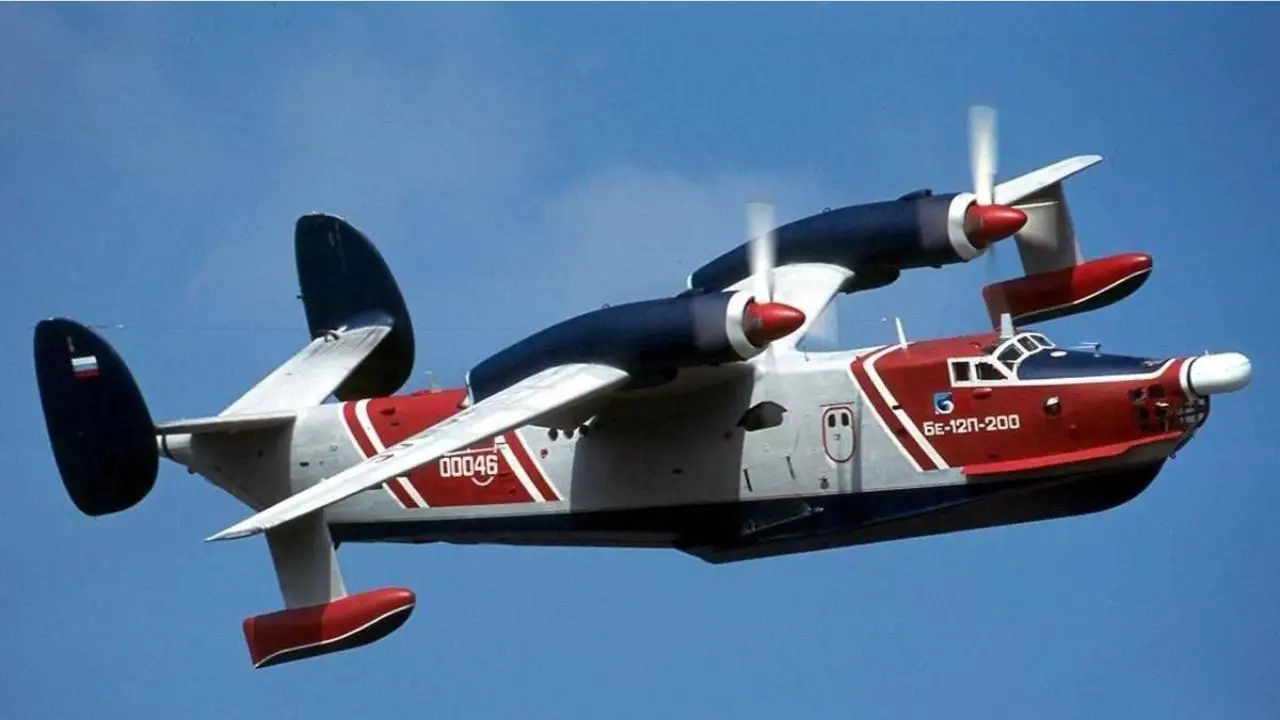The Taganrog Aviation Scientific and Technical Complex, which was named after G. M. Beriev, was actively engaged in the development of the Be-200, a new multipurpose amphibious aircraft, during the mid-1990s. One of the primary objectives of this project was to provide the aircraft with a state-of-the-art firefighting system that could effectively and promptly extinguish forest fires. To confront this technically intricate obstacle, it was determined to employ a modified anti-submarine amphibious aircraft, the Be-12, as a flying laboratory. The system’s first flight occurred on August 9, 1996, and was preceded by successful trials that demonstrated its capacity to deliver up to 12 tons of water to fire zones and replenish tanks in under a minute. The Be-12P-200 was active in firefighting operations across various regions in Russia, demonstrating the effective adaptation of a military seaplane platform into a vital environmental protection aircraft. The Be-200 benefited greatly from its crucial role in refining its firefighting capabilities. The new system facilitated the safe and rapid intake of water from the surface of water bodies during planing at optimal velocities, thereby reducing the stress on the aircraft’s hull and plumbing systems.
Powered by turboprops, the Soviet Beriev Be-12 amphibious aircraft primarily served maritime patrol and anti-submarine warfare (ASW) missions. Its maiden flight occurred on October 18, 1960. Two Ivchenko Progress AI-20D turboprop engines are mounted above the wings of the Be-12, which has a gull-wing design. This configuration enhances the aircraft’s speed and range in comparison to its antecedent, the Beriev Be-6. It is equipped with retractable landing gear, which allows it to operate from both water and conventional runways, thereby granting it amphibious capabilities.
The aircraft was equipped with the most advanced avionics available at the time, such as radar, sonar buoys, magnetic anomaly detection (MAD) systems, and electronic warfare devices, which were used to detect and engage submarines. It is capable of transporting armaments such as torpedoes, depth charges, mines, and conventional bombs, with an external payload capacity of approximately 3,300 pounds.
Between 1960 and 1973, approximately 150 Be-12 units were manufactured. It served mainly in the Soviet Naval Aviation and subsequently in the Russian Navy. It was equipped with a hermetic fuselage that was divided into compartments to ensure buoyancy, as well as floats beneath the wings to provide stability on water. The Be-12 is a rare example of an amphibious military aircraft that is still operational in certain capacities.
A serial Be-12 aircraft with factory number 8601301 was selected for the flight laboratory. The conversion work was conducted at TANTK from August 1994 to June 1996. By disassembling the aircraft’s bombing and anti-submarine armaments, the cargo compartment was made available for the installation of technical equipment. The cargo compartment was equipped with a substantial 4500-liter tank, while the nose section was equipped with two tanks that collectively possessed a 1500-liter capacity. Ground equipment was installed to replenish water at the airfield, and a complex system was installed to intake water from the water body during planning. Additionally, a water discharge system was installed. The aircraft was equipped with control and measuring instruments, aiming devices for precise water discharge, and instruments to analyze the environmental conditions in the fire zone, in addition to the water management systems.
Testing revealed that the process of filling all three containers was completed in no more than 50 seconds at a planing speed of approximately 120 km/h over the water surface. This rapid replenishing enabled the rapid discharge of water onto fire hotspots that were situated up to 100 kilometers from the water source. A total of 37 water intake and discharge modes were implemented between August and October 1996. The system’s effectiveness and reliability were verified by the results: a complete water intake required only 12–20 seconds, and its discharge was precise and controlled.
By delivering and releasing up to 140 tons of water in a single refilling session, the Be-12P-200 effectively suppressed forest fires. Furthermore, the system has the potential to establish a water barrier that would prevent the spread of fire in the event of gusty conditions. The aircraft’s powerplant, which consisted of two AI-20D turboprop engines, enabled it to operate in extreme climates with atmospheric temperatures exceeding +45 °C.
The Be-12P-200 was utilized in actual forest fire situations in various Russian regions, including the Irkutsk region, the areas near Gelendzhik and Yalta, the Rostov region, Chukotka, Yakutia, and Sakhalin, after the completion of tests and the confirmation of technical specifications. This flying laboratory also garnered attention and was featured at significant airshows, including MAKS-97 and MAKS-99, as well as specialized Hydroaviashows in Taganrog.
Consequently, the Be-12P-200 was instrumental in the successful implementation and mastery of the innovative firefighting system, thereby establishing a notable turning point in the advancement of Russian amphibious aviation and the safeguarding of forest areas from flames.
Official Website of Youtube Channel – Altitude Addicts
